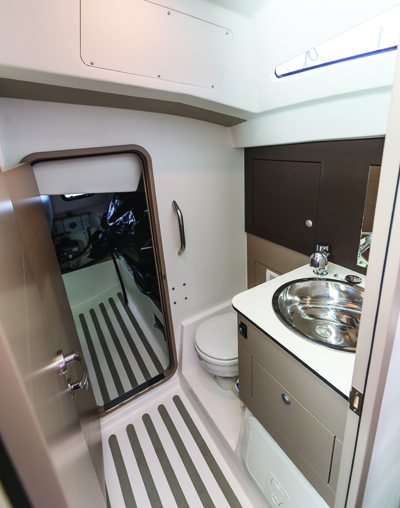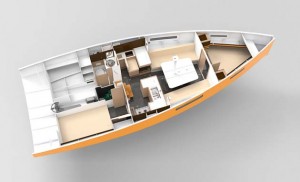For those after something a bit different from the norm, this sporty 35ft plywood family cruiser has plenty of colour and personality. Toby Hodges reports
RM1070 on test: the plywood family cruiser that dares to be different
Everyone stops to look when an RM sails by. I like to put it down to their individuality and character – traits not easily achieved on a typical volume production yacht.
RMs are built from the proper, honest stuff: wood. A subsidiary benefit of this, and the fact that they are not all finished in white gelcoat, is that a range of eye-catching colours is offered as standard – our test boat just happened to be off white!
But it’s not just colourful topsides that give an RM character – just because you wear red-framed spectacles or drive a turquoise Citroen it doesn’t make you intriguing. It’s personality and, as I was to find out, this new RM1070 has it in spades.
RM has built plywood epoxy yachts for over 25 years, using Marc Lombard designs for the last 20 of them. The 1070 is an evolution of RM’s most successful model, the 1050 from 1999, replaced by the 1060 five years ago. And now 26 of this new 1070 have already been sold since her launch a year ago. Not bad for a company used to producing 30-40 yachts a year.
Since our visit to the yard in autumn 2012, the brand has continued to grow in popularity by ensuring its models remain contemporary. The bold topsides are a well-recognised signature now, but for me it’s the muscular design that marks out the 1070, particularly her box fresh shape, reverse sheer and dreadnought bow.
And although RM has provided the option of twin keels for sailors wanting to take to the ground before, the 1070 has a versatile third option too: a swing keel that reduces draught from 2.92m to 1.15m.
Balanced blend
There is a selection of beamy, chined, sporty yachts around today, particularly from France. The majority tend to be lightweight, minimalist skimming dishes, such as the Pogos and Djangos, which are derived from Mini Transat racing yachts. I think of RM as more of a balanced blend between that more radical sporty end and conventional family production cruisers.
 I had a swift, entertaining sail on the 1070 from her home port of La Rochelle during our trials to choose the European Yacht of the Year in September. It was an appetiser which, like all good hors d’oeuvres, left me wanting more.
I had a swift, entertaining sail on the 1070 from her home port of La Rochelle during our trials to choose the European Yacht of the Year in September. It was an appetiser which, like all good hors d’oeuvres, left me wanting more.
My first impressions of the 1070 were that she feels like a larger boat for her length. She has a generous sailplan – indeed her ratios are more comparable to a performance boat such as the J/111 or a Pogo 1050 – a sign that RM is pushing more towards the sporty end of the cruising spectrum. This helps to explain why she heels relatively quickly and easily.
There she remains happily on a chine, an angle that presents reduced wetted resistance, yet provides those aboard with a fun sense of speed.
Playful, enjoyable boat
The 1070 is a playful, enjoyable boat to helm. You can feel the stiffness of her build, the combination of plywood epoxy and a metal structural grid. She has a neutral helm, typical for a twin rudder set-up, but with deep blades providing direct steerage.
 Upwind we made 7-7.5 knots in 11-12 knots of true breeze, reasonable figures that come with a pointing penalty though. In comparison with the Hanse 315 nearby, for example, we were pointing 10° lower, despite having a 3m deep lift keel. The test boat had a slightly overlapping genoa however; standard RMs are cutter-rigged with the option of a staysail/trinquette.
Upwind we made 7-7.5 knots in 11-12 knots of true breeze, reasonable figures that come with a pointing penalty though. In comparison with the Hanse 315 nearby, for example, we were pointing 10° lower, despite having a 3m deep lift keel. The test boat had a slightly overlapping genoa however; standard RMs are cutter-rigged with the option of a staysail/trinquette.
Her behaviour is typical of a modern, boxy, ultra-beamy cruiser. The triangular shape produces drag in light airs – if you look at the 1070 from behind you’ll notice her considerable wetted surface – and hampers the ability to point high. But in many cases, including aboard the 1070, this is more than made up for by a spirited performance offwind.
This was particularly noticeable when we hoisted a shiny red asymmetric spinnaker. The log quickly rose to average 8.5-9 knots in 12-14 knots of true wind. Point her up to a beam reach and she heels a little more and, with a little help from a slight wave, eases onto the plane. She even hit double figures briefly too.
Considering that RMs are not typical lightweight planing yachts – the 1070 is 1.3 tonnes heavier than a similar-sized Pogo 1050 – those are respectable figures. It will also help her win back some of that ground lost sailing upwind!
When I tested the larger RM 1260, I remember being a little disappointed that she didn’t plane, even when reaching in 25 knots of wind. The 1070 is that bit lighter, with a little more sail which, combined with a more modern shape and a longer waterline, means you get a bit more pace.
A cockpit to work in
Another real plus of an RM is the cockpit and sail control set-up. I like the way the mainsheet traveller utilises the extensive beam aft, which allows proper trim of mainsail shape. A German mainsheet system carries this sheet forward to the boom and back to winches within reach of each wheel.
Primary winches are fitted inboard, beside the companionway – something I am astonished more yards don’t do today. It avoids the need to try to grind while dangerously poised on the leeward rail and it allows a crewmember to stand upright to trim, let off a sheet with one hand and pull in the new working sheet with the other – all under the protection of the sprayhood. The 1070 also has a large bin to store the tails of running rigging at the companionway.
The open transom is still a feature that will take some getting used to on a cruising yacht, however. Triple guardwires and a crash bar across the transom might help prevent a crewmember disappearing overboard, but cockpit items could still get washed away, including sheet tails (check before engaging engine!).
Also, it adds to a feeling of exposure in addition to the wide aft beam.
Light and space below
Going below on an RM is like taking a revitalising tonic. It make you wonder why so many conventional monohulls feel enclosed, away from the very elements you have gone afloat to appreciate.
The 1070 incorporates an astonishing amount of natural light. The high coachroof allows the saloon (soles and furniture) to be raised, so it hardly feels as though you are descending into the interior. This also creates good bilge stowage beneath the saloon and galley.
RM’s formula is refreshingly different, with interiors that are basic, but comfortable. The 1070 is very much a no-frills, French-style boat. Once again, the use of bold colours plays a part; a choice of 12 different colours is offered for the upholstery, which helps give each RM its own style.
The interior is not only bright, but feels enormous – 13ft of beam obviously buys a lot of space in a 35-footer, but the fact that the painted ply finish has natural insulation, also avoids the need for liners. Although the cabins are rather Spartan, there is abundant practical stowage throughout.
The layout will suit cruising sailors. The galley is large, the saloon berths long (2.05m) and there is a proper navigation station. The saloon feels comparatively large, perhaps because the forward cabin is little more than a vee berth. The two-cabin format leaves the port aft area open for lazarette/workroom space, accessible through the heads.
It’s an excellent layout, one that is far more practical than trying to shoehorn in a third cabin, in my opinion.
A word about wood
Remarkably RM remains the only production yacht builder that builds hulls using plywood on frame. It is a skilled, technical and labour-intensive method, but one that is easy to understand and has several advantages.
Ply is lighter and more rigid than glassfibre, it provides thermal and sound insulation, and weight for weight it is stronger than steel. When bonded with epoxy resin it helps to create a durable, rot- and osmosis-resistant finish that is easy to repair.
But it is not a pliable product and it is a relatively expensive raw material. The sourcing of good-quality marine ply is essential for boatbuilding to protect against water ingress and delamination – but it is three times the price of standard ply.
Specifications
LOA 11.44m/37ft 6in
LWL 10.50m/34ft 5in
Beam (max) 4.00m/13ft 1in
Draught 1.68m/5ft 6in
Disp (lightship) 4,900kg/10,803lb
Ballast 1,600kg/3,527lb
Sail area (100% foretriangle) 70.2m2/756ft2
Berths 4-6
Engine Volvo Penta 30hp saildrive
Water 90lt/42gal
Fuel 80lt/18gal
Sail area:disp 24.7
Disp:LWL 118
Price ex VAT €155,000 (£109,432)
Price as tested €218,329 (£154,142)
Design Marc Lombard
Conclusion
You can tell I am a fan of RM yachts. Building in plywood epoxy is a smart, time-tested method, but it is a labour-intensive form of volume boatbuilding and so it does not come cheap. However, the 1070 does provide plenty of boat, with individuality, for her €155,000 base price.
The RM1070 is a fun boat to sail, with just the right balance of sportiness and cruising safety for an active sailing couple or family. And I am quite sure a family would be happier in that bright interior, with a basic, but tidy finish, than many other compact monohulls. The keel options also open up another world of shoal draught cruising.
It takes more than a lick of bright paint to give a yacht character. From her build material, to her contemporary shape, to her naturally floodlit interior, the RM 1070 is a boat for today.
She has oodles of character. She’s a yacht that proudly says: different is good.











